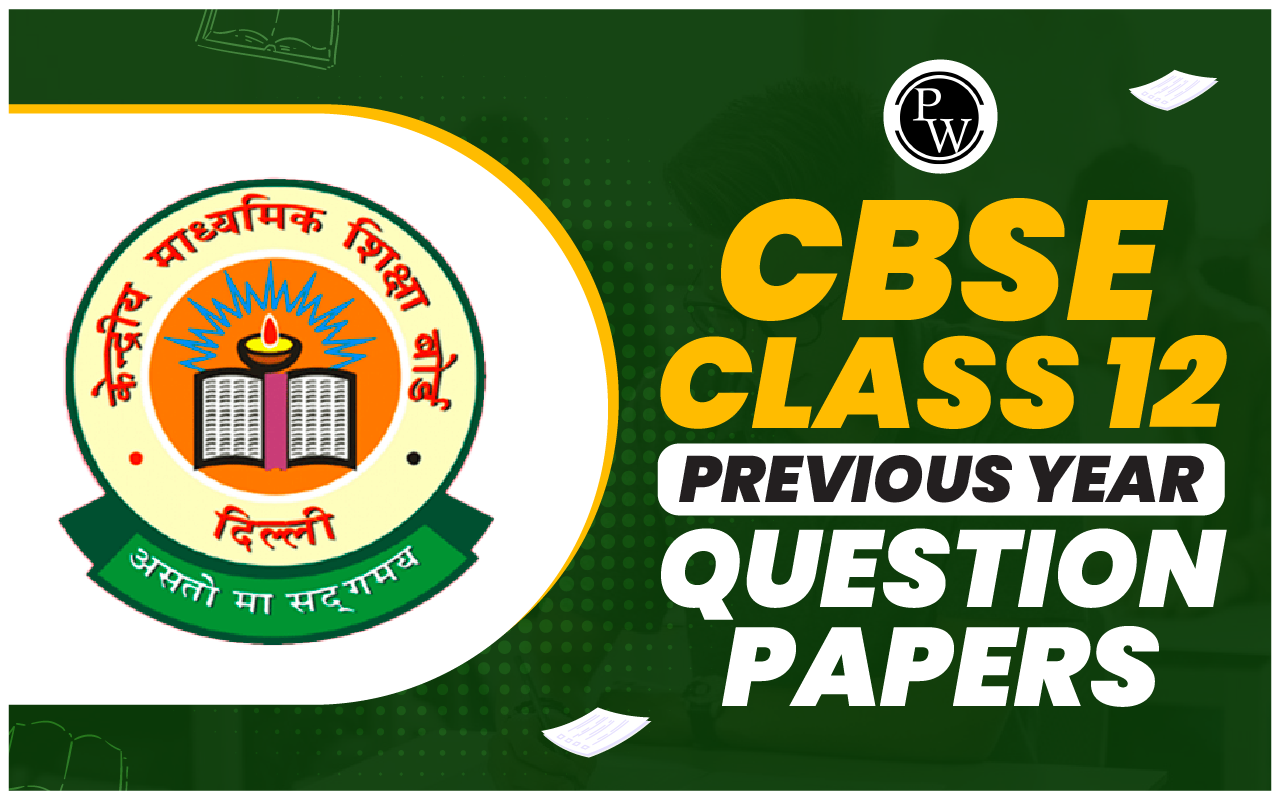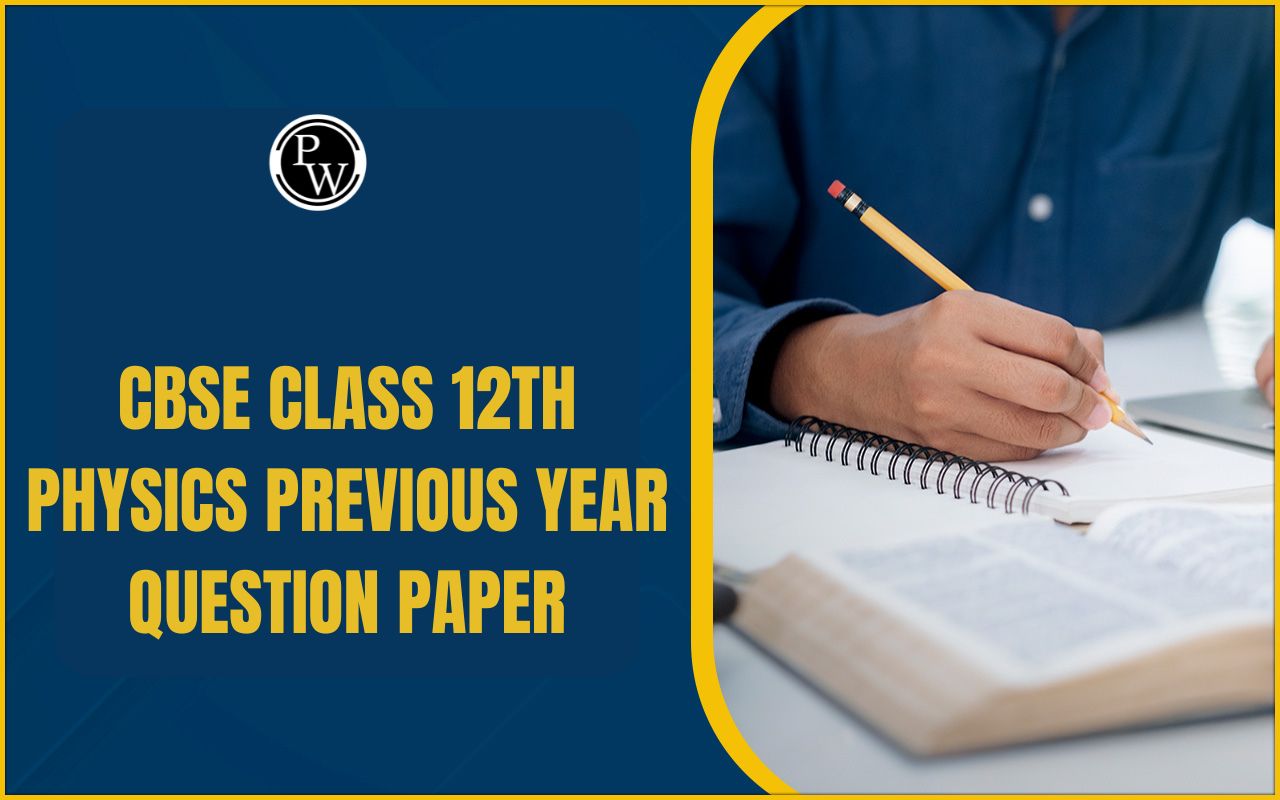
CBSE Class 12 Physics Notes Chapter 9: In "Ray Optics and Optical Instruments," Chapter 9 of CBSE Class 12 Physics, the behavior of light as rays is explored. It examines rules and phenomena such as complete internal reflection, critical angle, and refraction through lenses and prisms relating to light's reflection and refraction.
The chapter addresses how mirrors and lenses create images, with a focus on focal length, magnification, and optical tools such as telescopes and microscopes. Additionally, it discusses how rainbows originate, how light disperses, and how optical instruments work. Understanding the fundamentals of light and vision requires reading this chapter.CBSE Class 12 Physics Notes Chapter 9 Overview
The ray model of light is the subject of Chapter 9 of CBSE Class 12 Physics, "Ray Optics and Optical Instruments," and it is crucial to comprehend a variety of optical phenomena as well as how optical instruments function. The nature of light and the ideas of reflection and refraction are covered in the first section of the chapter. It covers the laws that govern these phenomena, including as the concept of superposition and Snell's law, which serve as a basis for examining how light behaves in various media.The chapter goes into detail on how spherical and plane mirrors produce pictures, elucidating important ideas like magnification, radius of curvature, and focal length. It also discusses the idea of a lens's power, the thin lens formula, the lens maker's equation, and refraction via lenses. The chapter devotes a good deal of space to optical devices, such as telescopes and microscopes. The operation of these devices is described, with a focus on how they amplify pictures by using the characteristics of mirrors and lenses. In addition, the chapter covers concepts that are essential to comprehending both the design of optical fibres and natural phenomena like rainbows, such as total internal reflection, critical angle, and dispersion.
CBSE Class 12 Physics Notes Chapter 9 PDF
This chapter is essential for students aiming to grasp the fundamental principles governing light and its applications in various optical devices. Hence, here we have provided CBSE Class 12 Physics Notes Chapter 9 Ray Optics and Optical Instruments pdf for the ease of the students.CBSE Class 12 Physics Notes Chapter 9 PDF
CBSE Class 12 Physics Notes Chapter 9 Ray Optics and Optical Instruments
Below we have provided CBSE Class 12 Physics Notes Chapter 9 Ray Optics and Optical Instruments -Reflection
A basic optical phenomenon known as reflection occurs when light bounces off a surface as opposed to travelling through it. According to the law of reflection, light reflects off of surfaces like mirrors at an angle equal to the angle of incidence. According to this law, the angle of reflection - the angle between the reflected ray and the normal- and the angle of incidence- the angle between the incoming ray and the surface normal- are equal. A medium with transparency is one that permits easy light transmission. (Sun, candle, electric arc, etc.) A translucent medium is one that allows for some partial light propagation. (paper, ground, glass, etc.)Opaque: This is a medium that allows light to travel through it. (For instance, iron and wood)
The feature of light known as reflection allows light that has been impeded by a surface to be redirected into the original medium.Laws of reflection
(a) At the point of incidence, the incident, reflected, and normal rays all reside in the same plane, which is perpendicular to the reflecting surface. (b) The angle of incidence and angle of reflection are equal. So, ∠ i = ∠ r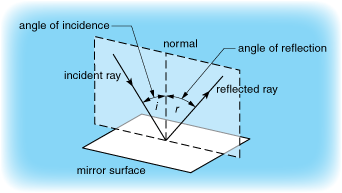
Concave mirror
One kind of spherical mirror that has an inward-curving reflective surface that resembles a sphere's interior is called a concave mirror. Due to the fact that it allows parallel light beams to converge at a single point known as the focal point, it is also known as a converging mirror. The following are a concave mirror's primary attributes: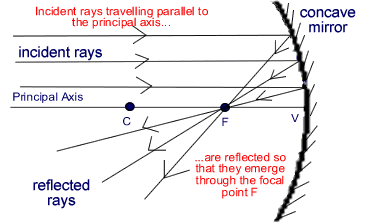 The point at which parallel light beams converge upon mirror reflection is known as the focal point (F) . The focal length is the distance measured from the mirror to the focal point. The centre of the sphere that contains the mirror is known as the centre of curvature (C). It is situated parallel to the reflecting surface.
The point at which parallel light beams converge upon mirror reflection is known as the focal point (F) . The focal length is the distance measured from the mirror to the focal point. The centre of the sphere that contains the mirror is known as the centre of curvature (C). It is situated parallel to the reflecting surface.
Principal Axis: The line that goes through the mirror's pole, or the centre of its surface, and its centre of curvature.
Image Formation: The distance of the object from the concave mirror determines the position, size, and type of image that is created. The image can be actual or virtual, inverted or upright, amplified or decreased, depending on the object's position in relation to the focus point.
Uses: Concave mirrors are used in solar furnaces, headlights on cars, shaving mirrors, reflecting telescopes, and other devices where light focusing is crucial.
Convex mirror
A convex mirror is a type of spherical mirror with a reflective surface that bulges outward, resembling the exterior of a sphere. It is also known as a diverging mirror because it causes parallel rays of light to spread out or diverge after reflection. The main characteristics of a convex mirror include: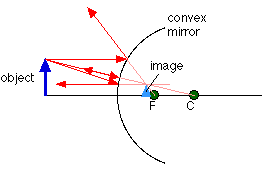
Focal Point (F) : The focal point of a convex mirror is virtual and lies behind the mirror. The reflected rays appear to diverge from this point.
Center of Curvature (C) : The center of the sphere of which the mirror is a part. For a convex mirror, this point also lies behind the mirror.
Principal Axis : The line passing through the center of curvature and the mirror's pole (the center of the mirror's surface).
Image Formation : The image formed by a convex mirror is always virtual (cannot be projected on a screen), upright, and smaller than the object, regardless of the object's distance from the mirror. The image appears to be located behind the mirror.
Applications : Convex mirrors are widely used in situations where a wider field of view is necessary. They are commonly used as rearview mirrors in vehicles, in surveillance, and in stores for security purposes, as they allow for a larger area to be viewed in a small mirror.
Mirror formula
The mirror formula relates the object distance (denoted by ), the image distance (denoted by ), and the focal length (denoted by ) of a spherical mirror (either concave or convex). The mirror formula is given by:
Sign Conventions
Object Distance (u) : Measured from the mirror along the principal axis. It is negative if the object is in front of the mirror (real object) and positive if behind (virtual object).
Image Distance (v) : Measured from the mirror along the principal axis. It is negative if the image is formed in front of the mirror (real image) and positive if behind (virtual image).
Focal Length (f) : It is negative for a concave mirror (focal point in front) and positive for a convex mirror (focal point behind).
Applications:
The mirror formula is crucial for solving problems related to image formation by spherical mirrors, helping to determine the position, nature (real or virtual), and size of the image formed.Refraction
The bending of a wave as it travels through a medium is known as refraction. The two substances' different densities are what produce the bending.Causes of Refraction
Change of Speed Results in Change in Direction
When a light beam enters a medium with a differing refractive index at an angle, it refracts. The direction changes as a result of this change in speed. Take the example of an aeroplane entering water. As light continues to travel at an angle, its speed diminishes.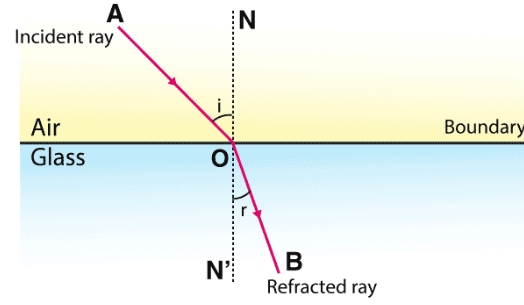 The above graphic illustrates how light refracts in glass. When light passes through glass from the air, it slows down and somewhat shifts its direction. Refracted light bends more in the direction of the normal line when it moves from a less dense material to a denser one. The light beam does not refract despite the change in speed if the light wave approaches the border perpendicularly.
The above graphic illustrates how light refracts in glass. When light passes through glass from the air, it slows down and somewhat shifts its direction. Refracted light bends more in the direction of the normal line when it moves from a less dense material to a denser one. The light beam does not refract despite the change in speed if the light wave approaches the border perpendicularly.
Total internal reflection
The phenomenon which occurs when the light rays travel from a more optically denser medium to a less optically denser medium. A light beam travels from a water-based medium to an air-based one. The intersection where the two media meet will cause a light beam to be refracted. The refracted light ray bends away from the normal as it moves from a medium with a higher refractive index to one with a lower index. The incident light beam is refracted at a certain angle of incidence such that it travels along the water's surface. The crucial angle is the name given to this specific incidence angle. In this case, the refraction angle is 90 degrees. The incident ray is reflected back into the medium when the angle of incidence is larger than the critical angle. This process is referred to as total internal reflection.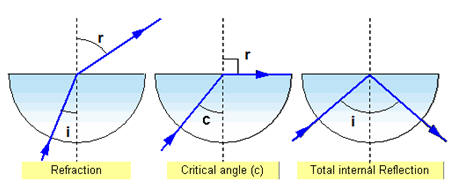
Dispersion
Dispersion refers to the phenomenon where the phase velocity of a wave depends on its frequency. In the context of optics, dispersion occurs when white light is separated into its constituent colors (spectrum) as it passes through a medium, such as a prism.Cause of Dispersion
Dispersion occurs because different colors (wavelengths) of light travel at different speeds when passing through a material, like glass or water. This variation in speed causes each color to refract (bend) by a different amount.Prism and Dispersion
Because each colour in the light spectrum has a distinct wavelength, when white light passes through a prism, it bends at a different angle. Red light has the largest wavelength and bends the least, whereas violet light has the smallest wavelength. A visible colour spectrum is produced as a result of this division.Lateral lnversion
The right side of the object appears as the left side in the image created by a plane mirror, and vice versa. We refer to this phenomenon as lateral inversion. An object's virtual, erect, and enlarged image is created when it is positioned between the concave mirror's pole and focus. For all object conditions, a convex mirror creates a virtual, erect, and reduced image. For a convex mirror, the focal length is considered as positive, while for a concave mirror, it is treated as negative.Resolving Power - The ability of an optical instrument to produce separate and clear images of two near by
objects, is called its resolving power.Limit of Resolution
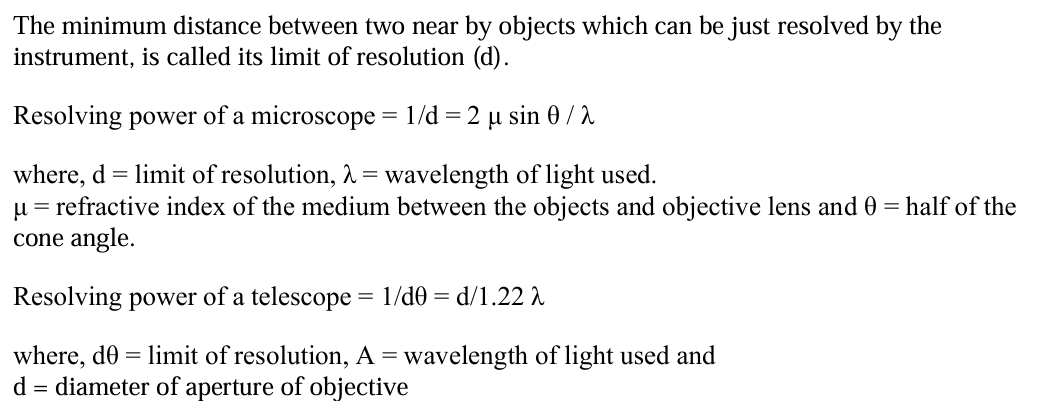
Benefits of CBSE Class 12 Physics Notes Chapter 9
The benefits of studying the CBSE Class 12 Physics Notes for Chapter 9, "Ray Optics and Optical Instruments," include:Conceptual Clarity : The notes provide a clear and concise explanation of key concepts like reflection, refraction, and image formation, helping students grasp the fundamentals of ray optics.
Efficient Revision : The notes are structured to cover all essential topics, making them an excellent resource for quick revision before exams.
Simplified Learning : Complex topics such as lens formulas, mirror equations, and optical instruments are broken down into easy-to-understand points, aiding in better comprehension.
Exam Preparation : The notes highlight important topics and frequently asked questions, helping students focus on the most relevant content for board exams.
Problem-Solving Skills : By covering various formulas and their applications, the notes enhance students' ability to solve numerical problems related to optics.
CBSE Class 12 Physics Notes Chapter 9 FAQs
Are CBSE Class 12 Physics Notes Chapter 9 helpful?
What is the purpose of ray optics?
What is the purpose of using optical instruments?
What are the basic concepts of ray optics?
What are the limitations of ray optics?


